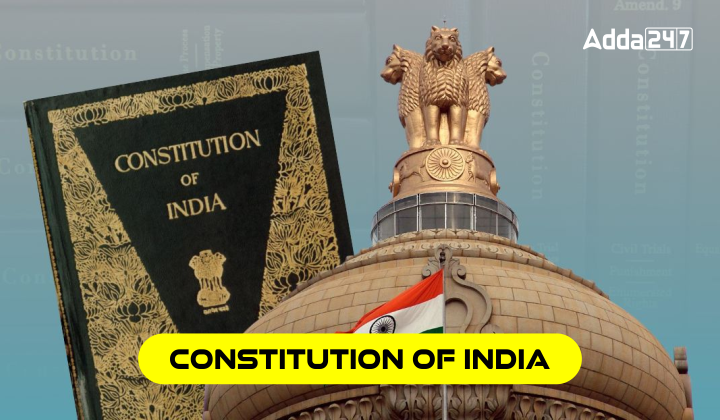Table of Contents
Constitution of India: A thorough understanding of the Indian Constitution is essential for anyone hoping to do well on any competitive exam that focuses on Indian Polity. This information is highly important for the General Studies Paper II (GS-II) political course in the IAS Exam. Proficiency in the Constitution, encompassing the Preamble, is crucial for achieving success in the UPSC examination and is a fundamental element of the polity segment. Prospective Indian Administrative Service (IAS) applicants ought to become well-versed in the Indian Constitution. For additional research, a printable PDF of the notes is also available. This article offers comprehensive information on the subject.
What is the Constitution of India?
The spirit and content of the Indian Constitution are distinctive. While it incorporates elements from various constitutions globally, it stands as a unique creation. Numerous amendments, including the 7th, 42nd, 44th, 73rd, and 74th Amendments, have significantly altered the original constitution.
Amendments of the Constitution of India
- The flexibility of the Indian Constitution allows for amendments by Parliament through specific procedures. Over time, significant changes have been introduced to the Constitution of India, with key amendments including the 42nd and 44th Amendments.
- The 42nd Amendment, often referred to as the “Mini Constitution,” brought about extensive modifications during the Emergency in 1976. Notably, in the Kesavananda Bharati case of 1973, the Supreme Court clarified that Parliament, under Article 368, does not possess the authority to alter the fundamental structure of the constitution.
Preamble of the Constitution of India
- The American Constitution was the first to commence with a preamble, and the Indian Constitution follows suit. Serving as an introduction or preface, the Preamble encapsulates the essence of the Constitution. Constitutional expert N. A. Palkhivala aptly labelled it the ‘Identity card of the Constitution.’
- Derived from Pandit Nehru’s Objective Resolution, which was presented and adopted by the Constituent Assembly, the Preamble underwent an amendment in 1976 through the 42nd Amendment. This amendment introduced the words ‘socialist,’ ‘secular,’ and ‘integrity’ to the Preamble.
Ingredients of the Preamble: The Preamble comprises four elements:
- Source of Constitutional authority: It asserts that the Constitution draws its authority from the people of India.
- Nature of the Indian State: It declares India as a sovereign, socialist, secular, democratic, and republican State.
- Objectives of the Constitution: It outlines the goals of justice, liberty, equality, and fraternity.
- Constitution adoption date: November 26, 1949.
Why Constitution of India is called Bag of Borrowing?
The Constitution demonstrates the wisdom of the nation’s founding fathers by including many borrowed characteristics. They shrewdly incorporated the best aspects of other countries to create a constitution that was specifically tailored for India. Below is a list of various constitutions’ influences.
| Constitution | Borrowed Features |
|
British |
|
| US |
|
| Australian |
|
| Irish |
|
| Weimer Constitution of Germany |
|
| Canadian |
|
| South African |
|
Features of the Indian Constitution
The chief features of the Indian Constitution are described below:
Federal System with Unitary Bias:
The constitution establishes a federal government system in India, encompassing expected features of a federal state, including two government levels, the division of power, supremacy and rigidity of the constitution, a written constitution, and bicameralism. However, it also incorporates elements characteristic of a unitary form of government, such as single citizenship, a strong central authority, a single constitution, constitutional flexibility, the presence of all-India services, an integrated judiciary, the appointment of state governors by the Centre, emergency provisions, and more. Notably, the term ‘federation’ is absent from the constitution, and Article 1 specifies India as a ‘Union of States,’ suggesting:
- The Indian federation is not the result of an agreement by the states.
- States do not have the right to secede from the federation.
Parliamentary Form of Government
The way our government works is a bit like how the British government works. It’s called the parliamentary form, and it means the legislative (law-making) and executive (decision-making) parts of the government cooperate. We also call it the Westminster model, responsible government, and cabinet government. Importantly, this way of running the government isn’t just at the national level; states also follow it as per our constitution.
In India, the features of the parliamentary form of government are as follows:
- Nominal and real executives
- Rule of the majority party
- Collective responsibility of the executive to the legislature
- Membership of ministers in the legislature
- Leadership of the prime minister or chief minister
- Dissolution of the Lower House
There are fundamental distinctions between the Indian and British models, despite both adopting the parliamentary form of government. The Indian parliament is not considered a sovereign entity, unlike the British Parliament. Additionally, the Indian State has an elected head, given its republic status, while the British head is hereditary, reflecting the constitutional monarchy of Britain.
Structural and Functional Dimensions
- Article 79 establishes the Indian Parliament with two chambers: Lok Sabha and Rajya Sabha.
- The President is both the head of the executive and a constituent part of the legislature.
- The President cannot actively participate in house discussions.
- The President has the authority to summon and prorogue the houses.
- Approval from the President is necessary for a bill to become law.
- The President can dissolve the Lok Sabha.
- Special addresses are delivered by the President at the start of the first session after general elections and annually.
- Article 123 empowers the President to promulgate ordinances.




 TSPSC Group 1 Question Paper 2024, Downl...
TSPSC Group 1 Question Paper 2024, Downl...
 TSPSC Group 1 Answer key 2024 Out, Downl...
TSPSC Group 1 Answer key 2024 Out, Downl...
 UPSC Prelims 2024 Question Paper, Downlo...
UPSC Prelims 2024 Question Paper, Downlo...





